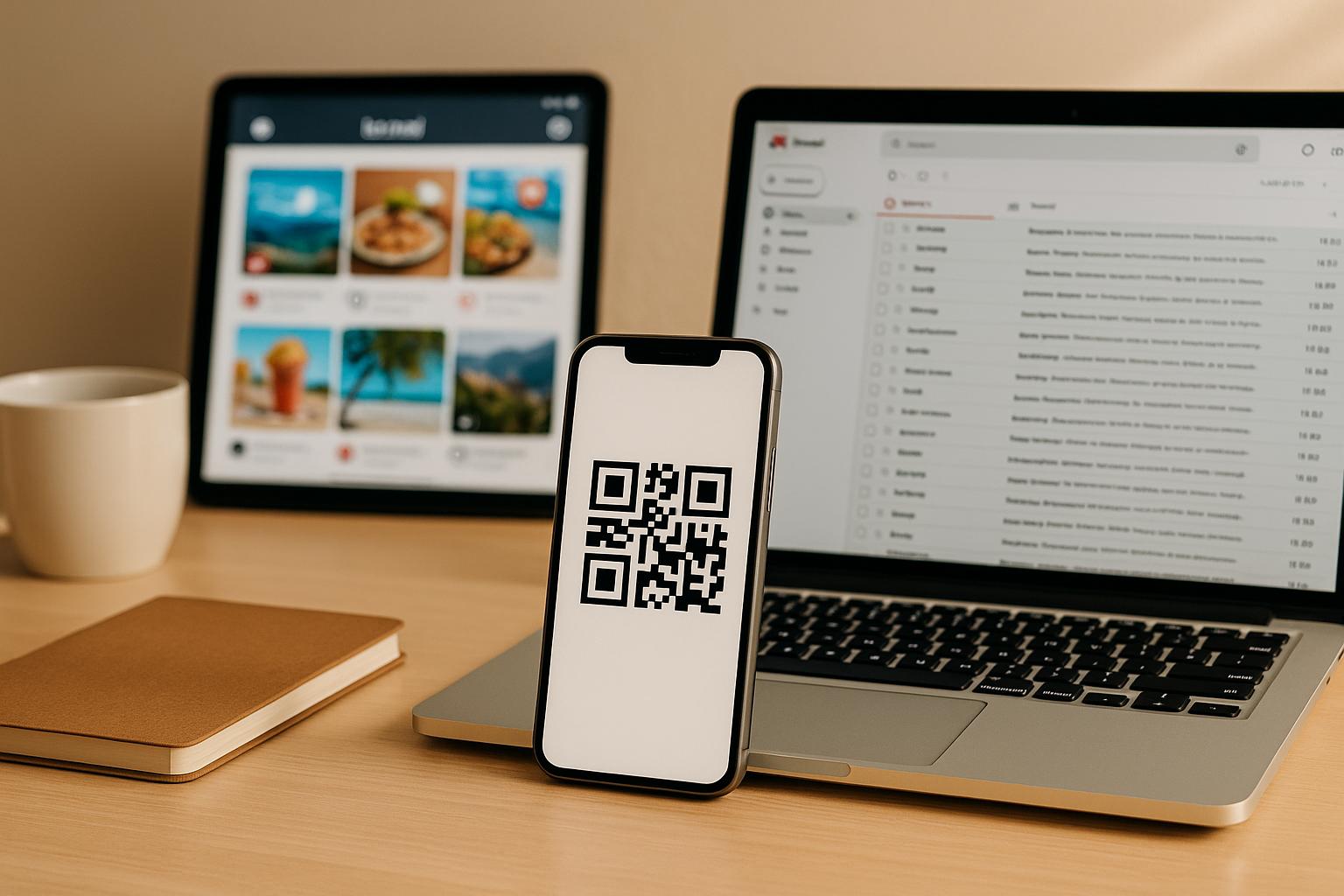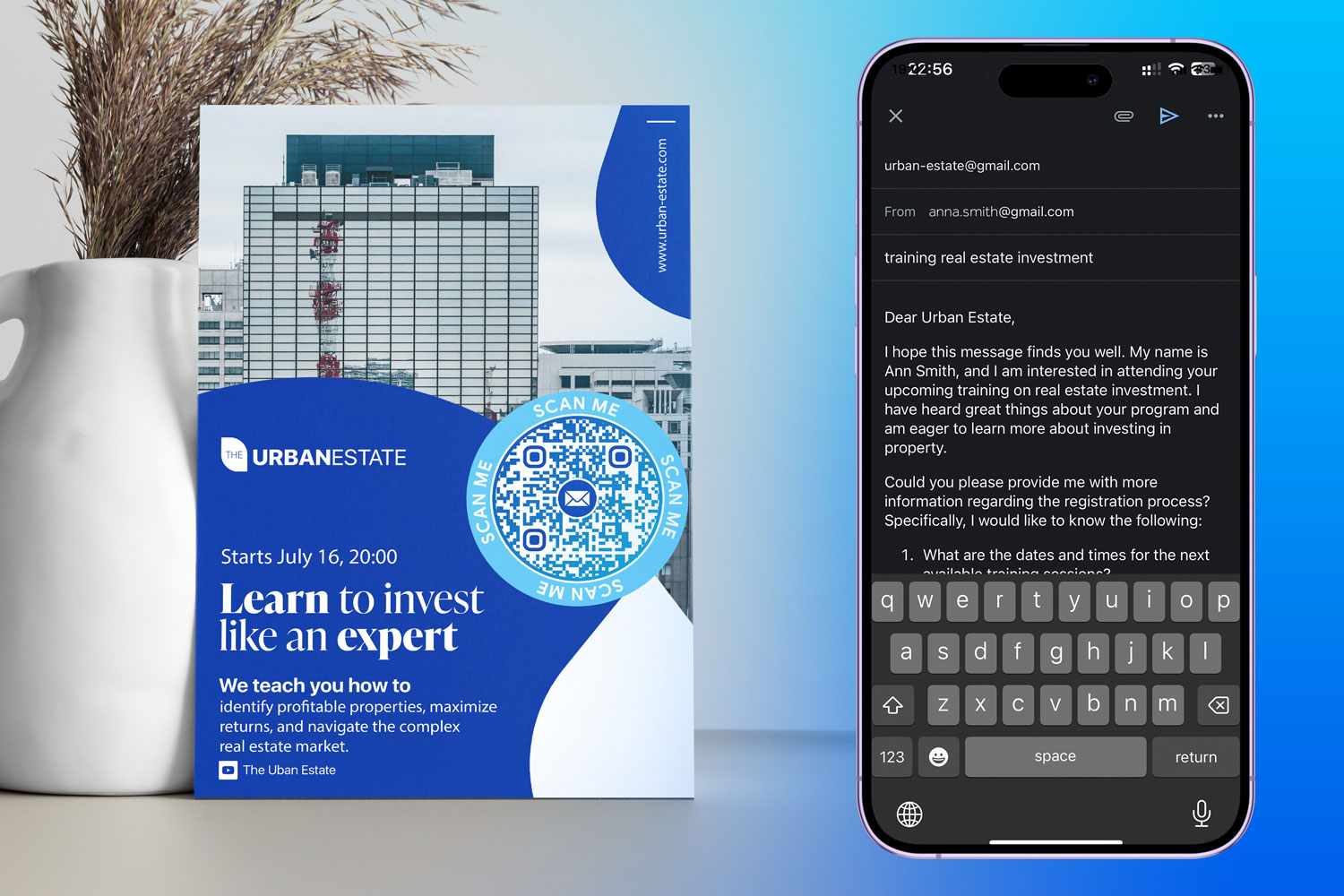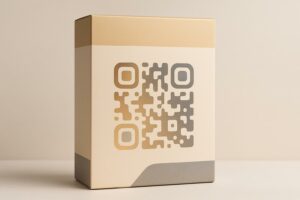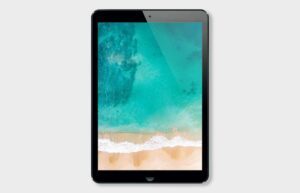Using QR codes that change with location is a wise way to give users just what they need, where they are. These are called dynamic QR codes and they switch up depending on the user’s spot. Unlike the usual QR codes, which always open the same web page, dynamic codes can direct users to pages, offers, or info that fit their location.
Key Highlights:
- Dynamic QR Codes: These codes can change their web link and let you target by location.
- Practical Uses: Shops, events, eateries, and travel firms use these for custom ads, paths, or local offers.
- Tools Needed: A good QR code tool, like Pageloot, helps in making, running, and keeping track of these smart QR codes.
- Privacy Matters: Always be clear about asking for location OK and keep to the rules like GDPR or CCPA.
Benefits:
- Personalized Engagement: Users see things that matter to them, based on where they are.
- Real-Time Adjustments: Swap content without needing new QR codes.
- Performance Tracking: Learn from scan spots, times, and how users act.
To start, make dynamic QR codes, set up location rules, and test a lot. Keep your brand look the same and put user privacy first to build trust. Tools like Pageloot make this easier. This way not only makes users more involved but also helps firms tweak their efforts well.
How to Redirect Users According to Their Country (Quick Steps)
Stuff You Need to Set Up Location-QR Codes
To use location-QR codes well, you need the right tools and the right content. These are important for a good campaign.
Why You Need Changing QR Codes
If you plan to use QR codes that change based on place, you need changing QR codes. Static QR codes are always the same, but changing ones use a short web link that you can update any time. This means you can change where people go based on where they are. For example, a scan in New York can take someone to a different page than a scan in California.
Changing QR codes also let you track a lot. They tell you where scans happen, what devices people use, and how well your campaign does – info that helps you make your plan better.
| Feature | Static QR Code | Dynamic QR Code |
|---|---|---|
| Can Change Content | Set when made | Can change when needed |
| Place Pointing | Doesn’t work | Works to show places |
| Track Use | Can’t track | Tracks who scans, where, on what |
| Look and Size | Big, not easy to change | Small, can change looks |
| Price | Usually free | May need to pay often |
While you can get static QR codes for free, you usually have to pay for dynamic ones. But, they let you track how well they work, change the info, and target users by where they live. So, for campaigns that need to be very exact, dynamic QR codes are a good choice.
Now that you get why dynamic QR codes are key, let’s see what tools you need to target by location.
Tools for Location Targeting
To use location-based QR codes well, you need a QR code platform with top features like location targeting, making changes, and tracking use. Pageloot is one such tool.
The platform you pick should let you make dynamic QR codes with rules. This means you can send users to different spots based on their area. You also need real-time tracking to see which places do best and to fix your plan if needed.
Branding matters too. A platform that lets you add your logo, colors, and other brand bits builds trust. This is key, especially if users might be wary of scanning an unknown code.
Also, make sure the platform can handle how many scans you expect without any issues. A slow or bad service can annoy users and mess up your campaign.
Next, get your content ready for different places.
Crafting Regional Content
To get people more involved, make custom content for each area. This might be special pages, deals, and notes that fit local likes.
Start by spotting what makes your target areas unique. Look at things like language, money, rules, and local ways. For global campaigns, having pages in the local language helps a lot. Even in the same country, making content for local shops, area deals, or time changes can really help.
For example, a food chain could show menus that match local tastes, while an online shop might push products that can ship quicker to some places. Adding local hours and contact info makes it even more personal.
This kind of tailoring is not just nice to have – it’s expected now. Data shows that 39% of customers now look for personalized QR code content. By making region-based stuff, you’re not just meeting these hopes but also making your campaign work better.
How to make location-based QR code changes
To get a system with location-based QR code changes, bring in alive codes, area rules, and test well to check everything goes right.
Make alive QR codes and put in place area rules
Start by picking an alive QR code service that lets you use area rules. This lets you send users to web links based on where they are. When setting up, pick the web links for each needed spot and pick a main web link for users not in those spots. Keep in mind, these area rules need users to say yes to giving their spot. Help them to say yes by clearly showing the plus side. For example, you could say: "Tell us your spot to see if things are at the store close to you." You can also mix area rules with other needs, like time or what device they use.
When you make area rules, begin with small, clear spots – 100 to 200 meters is a good start. Look at things like big things or land that might mess with GPS work. Testing will help you tune these spots later, so start little and grow as you need.
After the alive rules are good to go, make sure users feel good using your QR codes by adding your brand look.
Put your brand on QR codes
Branding helps build trust and gets users to try your QR codes, more so when you ask for their spot. Putting your logo in the middle of the QR code helps show off your brand. Most QR code services let you change the size and spot of the logo so the code works right.
Pick colors that go with your brand, but watch the mix so it scans well. Also, look at what your QR codes will be on. For example, small, light looks might fit well on business cards, but big, bold looks are good for posters or flyers. If your QR codes will go on varied things – like tags on goods or stickers on cars – make other looks, like light ones for dark spots, to keep them easy to see.
Test and fix your way to switch links
Testing is key for location-based QR codes, as many things can change how they work. Start by making sure the area rules do what they should and that users get the right thing based on their spot.
Test in lots of spots, on lots of devices, and in all sorts of settings. Use both Wi-Fi and cell links, including both 4G and 5G. Also, test in all sorts of light to make sure the QR codes scan right. For example, Audi of America had a go in March 2023 with alive QR codes that gave changed stuff based on spot and time. This try saw great results, including a 93% video end rate and more than 23,000 extra minutes of time with the brand.
Check your geofence setup by looking at your test scores. If people close to your aim spot don’t get sent right, fix the edges. Begin with small spots and grow step by step to keep zones from mixing. Also, test how you ask for place rights to make sure users know why they need to share where they are and that they are safe to do it.
"If your QR Codes aren’t location-aware, you’re missing an important context: where the customer is when they decide to engage." – Shashank D, Content Marketer at Uniqode
Write down any problems you run into during tests, and make a list for next times. This will help you keep the same good quality in all your place-based QR code tasks.
sbb-itb-74874c9
Boost QR Code Campaign Results
To make the most of your place-based QR code drives, it’s key to keep an eye on how they do and tweak them with data. By checking main numbers, you spot top spots, find out when most scans happen, and see which content clicks with your people.
Check How It’s Going with Stats
Dynamic QR codes are great for getting facts. They can check where scans happen, how users act, and how areas do. This lets you see how well your push is working. Numbers like when scans happen and how areas work are really useful. Tools like Pageloot’s stats board help you see trends and find chances.
For example, a drink firm found that 70% of their scans were in city spots. A real estate firm saw that their QR codes got more looks at noon and on weekends, letting them change when they show them for better results. A food service with QR code checks could use their ad money better by spending more in busy times. In 2022, 89 million in the U.S. used QR codes, mostly with phones, stressing that content must work well on mobile.
These facts help you make your drives better and mix them well into your big ad plan.
Link with Ad Tools
Mixing QR code data with ad tools gives you a full look at buyer acts. For instance, tying QR code visits to Google Analytics helps you weigh it with other web ways, showing how your place-based drives fit in your larger ad tries. Adding UTM tags to QR code URLs gives even more tracking, showing you just where or when the most useful visits to your site come from. This is good for firms running many drives or businesses like online shops that watch how areas do.
Ad tools like HubSpot and Zapier can push this further by making follow-ups and pulling in leads automatic. For example, when someone scans a QR code, they might get added to area-based email drives or get custom content based on where they are. This works well for firms with many spots – like food places or online stores – where sorting by place can make offers more sharp and hit better.
Better Your Area Drives
With your stats in hand and tools set up, use the data to tweak your area drives. Trying out A/B tests is a smart move to see what does best in different spots – be it QR code styles, web pages, or deals. With 51% of firms hunting for top stats in their QR tools, having good data helps you make your drives work best.
Start by looking at which places do well and which don’t. If some spots have low clicks, think about moving QR codes on stuff like flyers or posters, changing your QR code maker settings, or giving out special offers that fit what the area likes. If more people scan at certain times, try to change when and where you put them.
Using location info to make content can get you better results. Don’t use the same page for all. Make pages for each place that talk about local spots, use the local way of talking, or show close-by shops. This plan works well for jobs like real estate and healthcare, where messages for a specific place help a lot. Check your data every month to see what’s not working great and fix it soon. Even a small change, like using a video QR code instead of a PDF QR code, can really help get more people interested in certain places.
Being Safe with User Info
When you use QR codes to get the place where people are, you need to keep that info safe. It’s key to be open and careful with this info to keep trust and stay out of legal trouble.
Ways to Keep User Data Safe
To protect user data, you should code the location info when you send it and when you keep it. Use HTTPS and safe ways to store data to stop people who shouldn’t see it. Only let workers who need the data for their job see it. For example, let marketing see how well their plans work without them seeing where each user is by setting up rules in your QR code system. Also, set up a plan to remove data that you don’t need anymore.
Tools like Pageloot keep data very safe, meeting high standards. This means that checks by others show that they’re safe. Pageloot also lets you keep an eye out for odd things like many scans at once by setting alerts in your QR code plans.
Knowing the Privacy Rules by Place
Privacy rules change based on where you are, and knowing them helps you stay right with QR code plans:
- GDPR (European Union): Even if your business is in the U.S., you need a clear yes from users in Europe to get their location. Say someone in Germany scans your QR code, you need to be very clear in asking to get their place data.
- CCPA (California): People in California can ask what personal data you have on them and can tell you to delete it. Your dynamic QR code plans should let you quickly get and remove a user’s place history if they ask.
- HIPAA (United States): Health places have to be very careful. Like, if a hospital uses QR codes to help people find their way around, that data is highly protected and must follow HIPAA rules.
Also, some states in the U.S. have their own rules. Some need a clear yes to track locations, while others let it go for "real business needs." So, be very clear about how you handle data.
Be Clear When You Ask for Data
Being clear is not just safe; it’s also about talking plainly. Only ask for the place data if it makes things better for the user. Wait to ask for this data until you need it to show something specific. This builds trust and makes people more likely to say yes.
Tell people why you need the data in simple words. For example, studies show that if you tell people a clear reason – like showing items they can buy nearby – they are more likely to agree than if you’re not clear.
For those who don’t want to share where they are, have another choice ready. Send them to a page where they can pick their place or store, so they stay hooked with what you offer.
Keep your privacy rules easy to find and clear. Lay out what data you take, how long you keep it, and who gets it. Do not hide this info in hard legal words. On printed items like flyers or posters, put a short privacy note so users know what’s coming before they scan.
Always let users choose to share their location data – like with boxes they need to check themselves. This makes sure they know what they are saying yes to. For instance, Audi of America had a QR code drive aimed at locations that made it clear why sharing location data is good. The outcome? A 93% video finish rate and an extra 23,000 minutes with the brand.
Ending
Using QR codes tied to places lets firms reach folks better with content just right for their spot. This method makes sure the message hits the right eyes in the right area, boosting marketing work.
Success comes from changing QR codes, good data checks, and clear data ways. Changing QR codes are top-notch as they let you switch up content without new prints, easing spot-on targeting. Also, open talks on how you use data and following privacy rules make folks trust you when you use their spot data.
With these QR codes, firms spot where people plug in most, try out area deals, and form tight links with local folks. Whether you’re putting QR codes on biz cards, posters, or label goods, this plan adds worth to each scan.
To kick off, make a QR code with spot rules, add your brand, and check it real well. Tools like Pageloot make it easy to craft changing QR codes with top-level redirect and stats plans. Always show clear privacy notes and let users own their data. With smart steps, place-based QR codes can lift chats with customers and boost results for your firm. Each scan is a chance to touch base in a key way.
FAQs
How do moving QR codes change what shows up based on where you are?
Moving QR codes use the IP address place find to guess where a user is, getting facts like the country, city, or area. This skill lets shops change what they show or give away in certain places, making what they offer fit better for the people there.
Some smart QR code setups go even more by using GPS to track. This method gives clearer place facts, letting them use things like geofencing. With geofencing, people can get very local stuff or deals right where they are. All these parts work together to make a more special and fun time for users.
What are the risks of using QR codes that track where you are, and what can firms do to follow rules like GDPR or CCPA?
When you use QR codes that track locations, there are big risks about privacy. This is mostly because they track where a user is. If firms take this data without asking clearly, they might break laws like GDPR or CCPA. These laws are made to keep user data safe and make everything clear.
To follow these laws and keep trust, firms must:
- Ask users clearly before they take any data about location.
- Tell users how they will use their data in a clear way.
- Keep this sensitive data safe using good methods to protect data.
- Make sure only the right people can look at the data.
By doing these things, firms can use QR codes that track locations in a way that keeps user privacy safe.

























